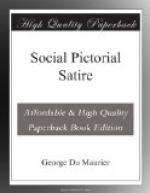Leech, no doubt, had a good natural hand, that swept about with enviable freedom and boldness, but for want of early discipline it could not execute these miracles of skill; and the commands that came from the head also lacked the preciseness which results from patiently acquired and well-digested knowledge, so that Mr. Hand was apt now and then to zigzag a little on its own account—in backgrounds, on floors and walls, under chairs and tables, whenever a little tone was felt to be desirable—sometimes in the shading of coats and trousers and ladies’ dresses.
But it never took a liberty with a human face or a horse’s head; and whenever it went a little astray you could always read between the lines and know exactly what it meant.
There is no difficulty in reading between Keene’s lines; every one of them has its unmistakable definite intimation; every one is the right line in the right place!
We must remember that there are no such things as lines in nature. Whether we use them to represent a human profile, the depth of a shadow, the darkness of a cloak or a thunder-cloud, they are mere conventional symbols. They were invented a long time ago, by a distinguished sportsman who was also a heaven-born amateur artist—the John Leech of his day—who engraved for us (from life) the picture of mammoth on one of its own tusks.
And we have accepted them ever since as the cheapest and simplest way of interpreting in black and white for the wood-engraver the shapes and shadows and colours of nature. They may be scratchy, feeble, and uncertain, or firm and bold—thick and thin—straight, curved, parallel, or irregular—cross-hatched once, twice, a dozen times, at any angle—every artist has his own way of getting his effect. But some ways are better than others, and I think Keene’s is the firmest, loosest, simplest, and best way that ever was, and—the most difficult to imitate. His mere pen-strokes have, for the expert, a beauty and an interest quite apart from the thing they are made to depict, whether he uses them as mere outlines to express the shape of things animate or inanimate, even such shapeless, irregular things as the stones on a sea-beach—or in combination to suggest the tone and colour of a dress-coat, or a drunkard’s nose, of a cab or omnibus—of a distant mountain with miles of atmosphere between it and the figures in the foreground.
[Illustration: THE SNOWSTORM, JAN. 2, 1867
CABBY (petulantly—the Cabbies even lose their tempers). “It’s no use your a-calling o’ me, Sir! Got such a Job with these ’ere Two as’ll last me a Fortnight!!”—Punch, January 19, 1867.]




